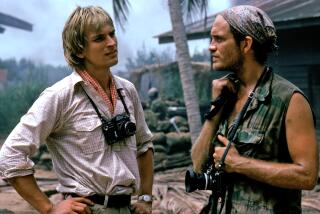Sid Davis, 90; producer of cautionary films for classrooms in ‘50s, ‘60s
- Share via
Sid Davis, an educational filmmaker in the 1950s and ‘60s who specialized in dark, cautionary tales crafted to frighten captive classroom audiences away from even thinking about misbehaving, has died. He was 90.
Davis died of lung cancer Oct. 16 at the Atria Hacienda senior residence in Palm Desert, said his daughter, Jill.
Before John Wayne lent him seed money to start his production company, Davis was best known as Wayne’s stand-in on movie sets. But he was inspired to jump into moviemaking when he saw that his 5-year-old daughter did not fully understand his lecture on the importance of avoiding strangers, she recalled.
“The Dangerous Stranger” (1950) was the first of more than 180 short films that Davis made, his daughter said. He became a prime producer of safety and social-guidance films that school boards across the country screened as a form of social engineering. The hope was that children would watch the films and adopt their toe-the-line message, according to experts.
“He wore his opinion on his sleeve and put it into his films,” Ken Smith, author of “Mental Hygiene: Better Living Through Classroom Films 1945-1970,” told The Times on Tuesday. “He meant well .... He was a straightforward man. There was no waffling with Sid.”
Many of Davis’ films were made for $1,000 -- a bargain even in the 1950s -- and often starred friends and relatives, Smith said. In “Live and Learn” (1951), his daughter cuts out paper dolls before she jumps up, trips and impales herself on scissors.
Many titles imparted stern messages about driving and highway safety, including “What Made Sammy Speed?” (1957). Others took on such transgressions as underage drinking, drug abuse, vandalism or venereal disease. A high school dropout, Davis warned against becoming one in “The Dropout” (1962).
“He grew up as a tough kid,” Smith said. “He didn’t want kids to follow the same path he did or suffer the same harsh lesson. That was his motivation behind most of his films.”
Davis was born April 1, 1916, in Chicago and moved to Los Angeles in 1920. A casting-director neighbor quickly got him and his mother jobs as extras, he told The Times in 1979.
Other extra work followed, including appearances in the “Our Gang” series until Davis grew too tall for the parts.
In 1941, Davis met another extra, Norma Henkins, and married her six weeks later; she died in 1996. Their daughter was born on Santa Catalina Island while he was stationed there in the merchant marine. In addition to his daughter, Davis is survived by a grandson.
In his late 40s, Davis took up hiking and had climbed Mt. San Jacinto near Palm Springs 643 times, including a dozen times in his 80s, his daughter said.
As a 6-foot-4 adult, Davis was Wayne’s stand-in from 1941 to 1952, his daughter said, and the pair often played chess between takes.
On one set, “the call came for the stand-ins to report,” Davis recalled in The Times article, “But it was my move on the chessboard and Duke wanted me to make it. So he went up and stood in for his own stand-in.”
When Davis had made enough money from his films to begin paying back Wayne, he wrote him a check for $5,000.
“Wayne tore up the check,” Jill Davis recalled, “and said, ‘Put it back in the business.’ ”
More to Read
Only good movies
Get the Indie Focus newsletter, Mark Olsen's weekly guide to the world of cinema.
You may occasionally receive promotional content from the Los Angeles Times.











